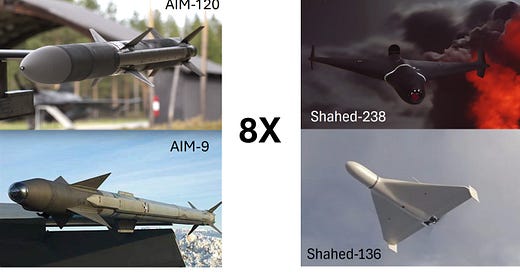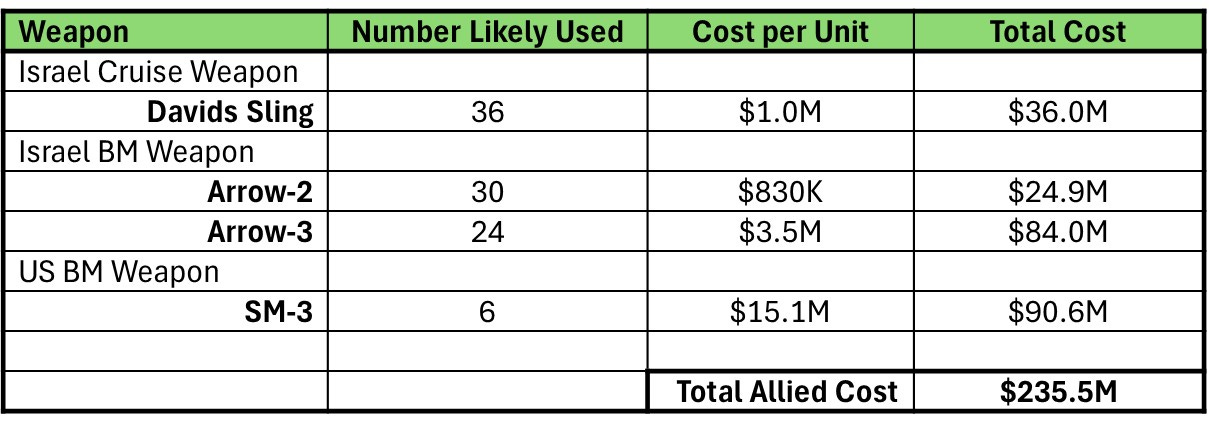Defending against drone and missile attacks in modern warfare requires assessing the costs and stockpiles as these attacks continue to scale.
Earlier this year CSIS issued a report where they showed that defensive capabilities are roughly twice as expensive as offensive ones. They highlighted that interceptor costs will fall for a time but jump as new capabilities are required to keep pace with new offensive capabilities. Overall, air and missile defense interceptors must possess exceptional speed, range, and sophisticated guidance to complete their challenging and precise missions.
This 2:1 ratio of defense to offense played out again over the weekend as Iran unleashed a combination of drones, cruise missiles, and ballistic missiles at Israeli territory. Thankfully, the attack was mostly thwarted through the combined efforts of multiple countries and multiple defensive systems.
The attack from Iran was a sophisticated one clearly intended to test the defenses of a well-armed country. According to Israeli sources and IRGC telegram reports, below are the rough numbers of assets launched and the types of capabilities used. It is possible there are more variation of weapons used as Iran has a growing suite of capabilities. We make some assumptions about the mix of drones, the type of cruise missile used, and the variants of ballistic missiles. U.S. missile costs are derived from CSIS analysis. Other costs are derived from various sources that may not be 100% accurate but provide a ballpark assessment.
Drones vs Fighters
Iran
Iran launched ~185 drones at Israel, a mix of Shahed-131, 136, and 238 variants. The estimated mix of drones along with public estimates of the cost of each are as follows.
Allies
On the allied side, it appears that the U.S, downed the majority of the drones, followed closely by Israel. Jordan and the UK contributions are vague with Jordanians saying they downed “dozens” and the UK “a small number.”
U.S. 85
Israel 65
Jordan 25
U.K. 10
News reports highlighted that the U.S. destroyed 85 drones using primarily F-15Es and possibly some F-16s. For a counter-drone missions, F-15Es and F-16s would use the AIM-120D (AMRAAM) at $700K and AIM-9X (Sidewinder) at $400K. We estimated the mix of missiles even though it is possible they used one type exclusively or even employed their on-board cannons.
Consider this engagement at scale (one missile per drone kill):
$700K AMRAAM vs $90K Shahed-238 = 8X cost ratio
$400K AIM-9X vs $50K Shahed-136 = 8X cost ratio
Putting aside the development and production costs of F-15Es, the cost per flight hour for F-15Es is ~$33K. Assuming 20 F-15Es X 5 hours X $33K/hour = $3.3M, which is likely understated. If we assume the allies had comparable costs for roughly the same number of fighters, we could double this to $6.6M for aircraft costs.
Total allied weapons and aircraft flight costs to defeat Iranian drones: ~$136M
($8.4M vs $136M) = Iran imposing 16X cost ratio on Allies to defeat the drone attack.
Even if more expensive seaborne weapons are excluded and the match-up is purely between an AIM-120D or AIM-9X and Shahed drones, the loss ratio is 8x.
Beyond costs, there’s the limited stockpiles of critical munitions required across multiple theaters. According to the Air Force’s FY25 budget request documents, the Air Force budgets for these two missiles include the following quantities:
If the Air Force used all of the cheaper AIM-9X missiles to defeat the Iranian drones, they would have used over HALF their planned FY25 production quantity to defend against this single attack.
Missile Defense
Iran
Given Iran’s recent attacks in Iraq and reports from IRGC sources, it seems likely that a mix of short and longer-range ballistic missiles were likely employed. Costs are not confirmed for Iran’s cruise and ballistic missiles, so a rough figure was employed here based on other similar missiles.
Allies
Israel bore the brunt of the cruise (36) and ballistic missile (54) defenses with the U.S. defeating six ballistic missiles.
The Iron Dome appears to have been too short-range to play a role, so the bulk of the defense came from David’s Sling and Arrow missile defense systems. We assume that David’s Sling was primarily focused on drones and cruise missiles with the Arrow systems focused on the ballistic missile attacks.
($354M vs $236M) = Iran outspent the Allies by $120M on cruise and ballistic missiles.
Total Cost Summary
All told, the Iranians and Israel-allied countries both roughly spent $360 - $400M in kinetic offensive or defensive weapons. Some estimates have it significantly higher. If the Iranians had not had half of their ballistic missiles fail, the defensive costs would have increased nearly $200M bringing the ratio closer to 2:1.
Apart from the failed ballistic missile launches, the reason the costs were so balanced was that Iran chose a mixed-attack approach combining sophisticated cruise and ballistic missile attacks combined with cheaper drones. Iran’s sales of Shahed drones to Russia and other countries may have depleted their domestic inventory.
Regardless, with a greater mass of cheap drones that Israel and its allies would have had to intercept with much more costly weapons would have shifted the ratio closer to an 8:1, meaning the defender expends 8X more than the attacker.
Moving forward, the U.S. and Allies require more cost effective means to defeat Shahed drones and related threats. Directed energy weapons offer great promise, yet mixed results to date. DoD leaders have championed accelerating and scaling the production and deployment of Counter UAS systems (directed energy and kinetic) to our Combatant Commands and allies. These attacks will continue to scale. We cannot afford to continue to employ costly and limited fighters and missiles to defeat them.
Defense Tech and Acquisition is a reader-supported publication.
To receive new posts and support our work, consider becoming a free or paid subscriber.














In addition to the Israel-allied countries cost mentioned above, there is also a logistics cost to transport and store the weapons. That the logistics transport distant is a function of the distance from the supplier to the use of the weapon. Thus, the IndoPacific cost in dollars and time exacerbates the cost to defeat drones
Is there a breakdown or BOM cost of drone hardware ? Would be interesting to see a Pareto of the highest cost drivers. For example in iPhones it’s the display and pcb. In automotive it’s usually seats, body, etc.